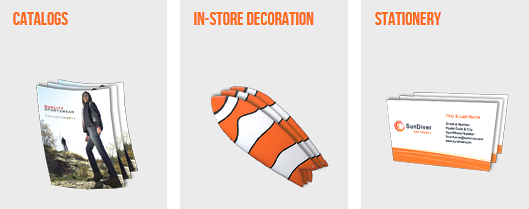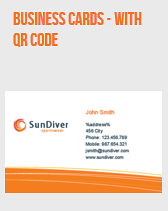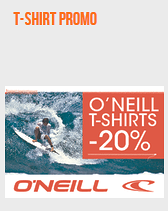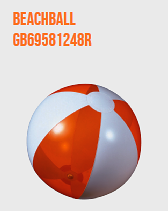:Apogee StoreFront in-depth
Products and categories
A web-to-print store created using Apogee StoreFront can contain a wide range of products that shoppers can order. To simplify navigation these products are organized into categories. There are five different types of products, ranging from documents that the user can customize to publications that are delivered from stock. Each product can have a number of options associated with it, such as a choice of different paper stocks.
Categories
Within a store products are grouped into categories. Categories can contain specific types of products, such as 'Stationery' and 'Datasheets'. They can be used to group print products by their subject, such as 'Textiles' or 'Screws'. Categories can also refer to certain events, such as '2013 Summer Campaign', or they can refer to certain groups of people, such as 'Team North'.
The number of categories, their names and their sorting order can be customized. To indicate their use, an image can be associated with each category, as shown below.

Within a category the sorting order of available products can also be customized. This is often done to make popular products appear at the top of the page. Adding a price bubble or a starburst are other ways of drawing attention to certain products.
Product types
Apogee StoreFront supports five different product types:
- Customizable products
These are products such as business cards that a buyer can personalize. Apogee StoreFront comes with a powerful Online Editor that allows complete customization of documents. This can be done using a form that the buyer needs to fill in or the document can allow free design. The latter enables the user to add text, upload images or use artwork from a library that is included with the document. - Uploadable products
These are products for which the user will supply a finished layout. When the buyer purchases the product, he or she must upload a PDF, TIFF or JPEG file. Stores can be configured to validate the incoming data. Such a preflight check assures that the document contains all the required fonts and that all the images have the appropriate resolution to guarantee good output quality. Within a shop the printer can make a template available that the buyer can download. For a flyer this can for example be an InDesign layout that clearly indicates where the page will get folded and how much bleed should be foreseen. - On demand products
As the name implies these products only get printed when a user orders a certain quantity. This is ideal for short run products that are printed digitally. For on demand as well as stock products buyers can view the front cover and they can flip through the pages of the document. The flipbook function is implemented in HTML5, so that it can also be used on the Apple iPad and Android tablets. - Printed stock products
Many print service providers offer a warehousing service to their customers. They may print 20000 catalogs but instead of delivering all of these to the customer, the catalogs are put in a warehouse and smaller quantities get delivered whenever needed. This process is sometimes referred to as âpick and packâ. Within Apogee StoreFront a stock counter keeps track of the remaining quantity that is available. If a store is created for a specific business customer, they can also monitor the stock levels of their products. A configurable alarm level warns Apogee StoreFront administrators when stocks get low. - Non-printed products
As a service to their customers some print service providers also do warehousing for additional products such as pens, USB sticks or company gifts. For such items multiple product shots can be displayed in the store, allowing the buyer to see a product from various angles or to highlight specific details. Non-printed products also have a stock level that can be monitored by the customer and administrator.



Product details
Each product in a store has a number of basic specifications â such as its dimensions, binding style, the substrate it is printed on by default and possibly its page count. The print service provider can allow buyers to order certain options. These can include:
- Alternative substrates, such as different paper weights
- Color options, such as printing the back in black & white
- Various types of finishing
- Packaging options, such as delivering business cards in a nice box
- Delivery options, such as ‘Rush’ delivery
Apogee StoreFront automatically recalculates the total price based on the quantity and the options that a user selects. Displaying the price of products and options is however optional. In many B2B stores no pricing is displayed for products.
Products can be scheduled to become available in a store from a certain date onwards. This allows a marketing department to define when the posters and point-of-sales displays for a certain campaign become available. It is also possible to define an end date, so that the 2013 catalogs automatically disappear from the store on December 31, 2013.

More information
More information about Apogee StoreFront is available on its product page and on its ‘How it works’ page.


 RSS
RSS
